TELL ME About It: AAC Learning with ‘I Like Myself!’
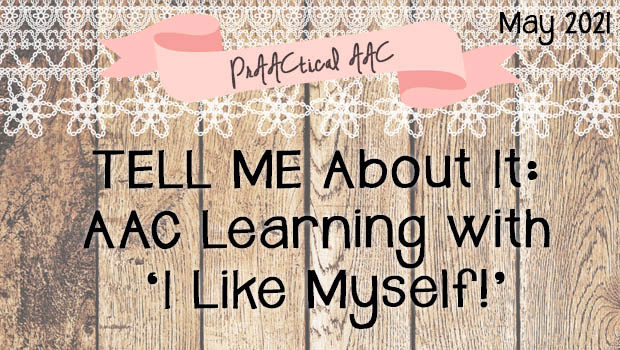
It’s time for another set of wonderful suggestions for robust implementation of core vocabulary support using the TELL ME program. Two amazing AAC SLPs, Maggie Judson and Jeanna Antrim, are the guest authors of TELL ME About It series and they’re back with prAACtical ideas for classroom activities, virtual learning tips, supporting AAC learning at home, and more.
Also, don’t miss their bonus resources or their video read-alouds of this month’s book with aided language input using three different AAC apps.
Maggie and Jeanna are speech-language pathologists who work in the Assistive Technology Department for the Belleville Area Special Services Cooperative (BASSC) in southern Illinois. They are AT/AAC facilitators and provide evaluations, direct therapy, consultations, and trainings with school teams.
If you are new to the series, you can check out their previous posts in the TELL ME About It series below.
- YEAR 1
- YEAR 2
TELL ME About The Book
The ninth book in this new series is “I Like Myself!” by Karen Beaumont. This book is excellent for building self-confidence and showing children how to be happy with their different and unique qualities! The creative illustrations and relatable storyline make this book great for asking open-ended questions and connecting to background information. Oh, and you know this book is full of wonderful core words as well! 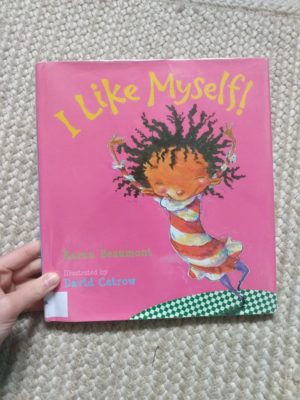
See below for the book focus for “I Like Myself!”:
Book Focus:
- Core Words (BOW WOW Words): I, LIKE, MY, DIFFERENT, GO, WANT, STOP, MINE
- Additional Words (Tiger Talk Words): down, head, feet/foot, walk
- Concept Vocabulary: body parts
- Book Concept: letters and words hold meaning
- Special Letters: t, p, o, n, c, d, u, g, h, f
TELL ME About Reading
Repeated Reading Focus: Story Props
Repeated readings offer an opportunity to work on all sorts of different literacy skills, which is why TELL ME recommends using the same book for two weeks (yay for repetition with variety!). For increased motivation and engagement during shared readings, we have found that story props are key. Story props can help improve students’ ability to connect to the book, use descriptive language, recall characters, and sequence events when retelling stories. And, they are just plain ol’ fun!
Adaptation Idea: Add sticky notes to turn the book into a flap book
Do you have students who love lift flap books? Well, to be honest, who doesn’t love a lift flap book!? They immediately turn a typical book into an interactive book, and when we have interactive books, we increase engagement, interaction, and motivation. One on-the-fly way to do this is by adding sticky notes (who doesn’t have these readily available?) to the illustrations in any book. Instant interactive adaptation! And what makes this easy adaptation even better are all the extra communication opportunities (“oh, I think you WANT to look under the flap”) now created by a simple sticky note! 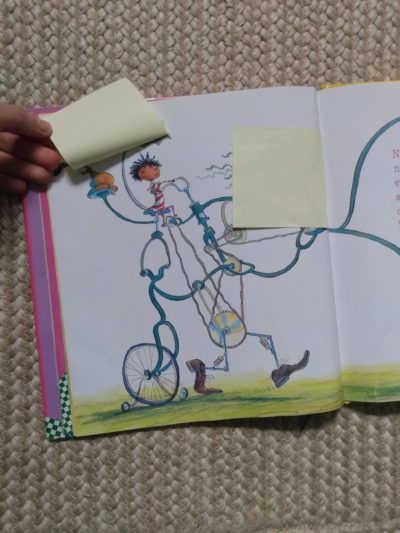
TELL ME About Writing
Writing is a big part of a TELL ME classroom! See below for ideas.
Predictable Chart Topic
- Title: I LIKE Myself!
- Sentence frame: I LIKE MY ______!
FUNctional Writing Activity
It’s spring here finally, which has us thinking of all the fun ways to incorporate writing while outdoors. A great way to create extra writing opportunities for authentic reasons is to write signs and labels for your classroom garden (even better, this can GIVE you a reason to start a classroom garden if you don’t already have one!). Support students to do letter-by-letter generative writing for each plant, flower, or vegetable on an index card, taped onto a popsicle stick or small twig, and put into the flower pots or garden beds. Easy peasy! But what if it rains and ruins the signs? Not to worry, this just gives us another genuine reason to make more signs!
TELL ME More
Below are some specific ideas on how to implement “I Like Myself!” in your therapy sessions and classrooms TELL ME-style!
Aided Language Input Tip – The 1-Up Method
Providing aided language input is one of those instructional strategies you will find yourself doing over and over (and over!) again in a TELL ME classroom. One natural technique to support language and communication is to repeat a student’s utterance and add another word to it. This technique helps to recast the utterance and expand upon it, giving them a demonstration of a longer, more complete phrase. Try this same technique with AAC! When a student says a word with their AAC system, provide aided language input for that word and add another word or two to it! Some examples (though ultimately what you say will depend on the specific situation and context):
- The student says STOP – “STOP + here”
- The student says GO – “GO + fast”
- The student says LIKE – “LIKE + that”
- The student says DIFFERENT – “get + DIFFERENT + toy”
- The student says WANT – “WANT + play”
- The student says MINE – “It + is + MINE”
Embedding Core into the Daily Routine
Fine Motor Activities
Fine motor activities are typically a routine-based part of a preschool classroom, making them a natural time to incorporate the target core words into different rote phrases. Having some predetermined scripts can support communication partners as they become comfortable targeting core words and providing aided language input.
Some examples:
- “I LIKE”
- “You are looking at the scissors, I think you WANT to do some cutting.”
- “I am GOing to write MY name”
- “You wrote your name with a DIFFERENT color!”
- “You put all the beads on the string, you can STOP”
- “Your block tower has 5 blocks, MINE has 3 blocks”
Craft – Body Portrait 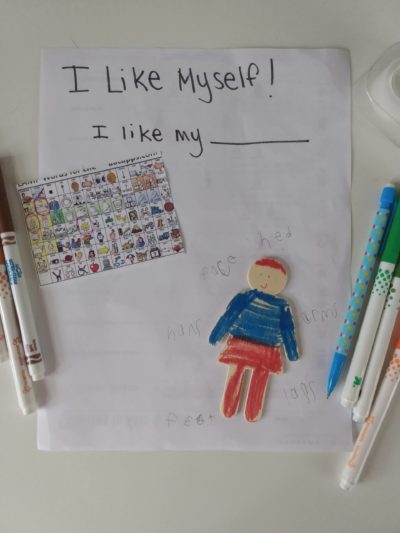
- Materials:
- Paper or cardstock
- Cut out body shape or free draw a body shape
- Crayons, markers, stamps, paints
- Pencil, pen, or alternative pencil
- Scissors
- Glue, tape
- Decorating materials, such as stickers, pom-poms, ripped up paper, yarn
- Optional (but so fun!) – Mini manual communication board with target core words circled
- Crafts and art projects can be a great way to create communication opportunities. Think of all of the communicative functions, such as requesting desired items, requesting assistance, directing actions, commenting, protesting, describing, labeling, asking/answering questions, that we can elicit and provide aided language input for! Some examples for the craft mentioned above could be:
- “I WANT to color my FEET green”
- “I LIKE MY HEAD!”
- “You are looking at the crayons, I think you WANT a DIFFERENT color”
- “You are coloring more, GO GO GO!”
- “MINE is finished”
- “You STOPped, I think you are finished”
Hi there! We love incorporating writing into any and all activities, including crafts. You too?! Yay, let’s be friends! Part of a TELL ME classroom is to work in literacy instruction all throughout the day, so don’t forget craft time. This craft lends itself perfectly for independent letter-by-letter generative writing to label body parts and write about all the things we like about ourselves. Yay for writing for authentic, fun reasons!
Virtual Learning Resource – Mister Clay YouTube Channel
If you haven’t already subscribed to the Mister Clay YouTube channel, you are totally missing out! We absolutely love sharing these videos with our families and school teams, especially during remote learning periods. The videos are engaging and a great demonstration of how to provide aided language input during activities we often participate in daily. Be sure to check out this resource and support the channel by subscribing!
BONUS Virtual Learning Resources!
- Check out Jeanna’s @speechwithoutlimits additional virtual learning resources! I Boom Deck, I YouTube video, LIKE Boom Deck, LIKE YouTube video, MY Boom Deck, MY YouTube video, DIFFERENT Boom Deck, DIFFERENT YouTube video, GO Boom Deck, GO YouTube video, WANT Boom Deck, WANT YouTube video, STOP Boom Deck, STOP YouTube video, MINE Boom Deck
- Check out Maggie’s @the.bookish.slp additional virtual learning resource! I YouTube Videos, I Boom Deck, I Digital Book, LIKE YouTube Videos, LIKE Boom Deck, LIKE Digital Book, DIFFERENT YouTube Videos, DIFFERENT Boom Deck, DIFFERENT Digital Book, GO YouTube Videos, GO Boom Deck, GO Digital Book, WANT YouTube Videos, WANT Boom Deck, WANT Digital Book, STOP YouTube Videos, STOP Boom Deck, STOP Digital Book.
TELL ME at Home
Simple Shared Reading Tip: Letter Awareness
One of the goals of shared reading is to provide experiences around the alphabet and letter sounds all day long, such as by drawing attention to rhyme, rhythm, alliteration, and words and sounds in sorts of different activities. The key to alphabet learning is that it should be meaningful, interactive, and fun! Some simple ideas to work letter awareness in (from http://literacyforallinstruction.ca/alphabet-phonological-awareness/):
- read alphabet books, and bonus points if it’s based on your child’s specific interests!
- point out letters and print in the environment, such as on storefronts or traffic signs
- talk about letters and their sounds when you encounter them in everyday activities, such as words or letters on clothing and on food containers (who doesn’t love looking at their favorite cereal box?!)
- provide opportunities to play with letter shapes and sounds, with letter magnets on the fridge or toys such as Leapfrog Letter Factory
- explicitly reference letter names and sounds in shared reading and writing activities, which ties in perfectly with verbal and nonverbal print referencing that we discussed in previous blogs!
Self-Reflection Tip
“Language, in general, is elicited frequently from students”
The TELL ME program is all about helping us as educators develop good AAC teaching practices and routines that we can implement when planning other lessons. But to do this, we have to reflect on how we are providing instruction. Last month, we talked about using aided language input for a variety of communication functions. This month, reflect on that suggestion with the question “language, in general, is elicited frequently from students” from the fidelity checklists available in the TELL ME program.
After reflection, would you answer this question as:
- ALWAYS
- SOMETIMES, or
- RARELY?
If after thinking about the past month you answer this as SOMETIMES or RARELY, that’s okay! We all start somewhere! We encourage you to think through what changes you can make to your teaching practices and routines to support your classroom assistants as they develop their skills to actively facilitate student learning.
Because remember: self-reflection and receiving constructive feedback helps you plan for your next session and get better at providing TELL ME-style instruction!
———————————————————————————————————————
To read more about how we prepare for a TELL ME week, check out our previous posts in the TELL ME About It series!
Be sure to check back next month as we work through the TELL ME manual and share activities, teaching strategies and implementation tips for the next book in this new series, “If You Give a Mouse a Cookie”!
RESOURCES and REFERENCES
Aided Language Stimulation video – Icpsat: https://www.youtube.com/watch?v=flFNMky22-U&feature=emb_logo
Literacy Instruction for Students with Significant Disabilities – ALPHABET AND PHONOLOGICAL AWARENESS http://literacyforallinstruction.ca/alphabet-phonological-awareness/
You can purchase the TELL ME manual from the Attainment Company (www.attainmentcompany.com/) or from ASHA (bit.ly/2XF1w1r).
You can learn more about the program by watching the webinar TELL ME: AAC for the Preschool Classroom presented by Dr. Carole Zangari, available from Saltillo (bit.ly/2RNpykn).
Check out the videos of us reading the book “I Like Myself!” while providing aided language input:
- Snap Core First
- LAMP Words for Life
- TouchChat with WordPower
Follow us on Instagram @basscAAC and subscribe to our YouTube channel (basscAAC) for more AAC implementation ideas!
:::::::::::::::::::::::::::::::::::::::::::::::::::::::::::::::::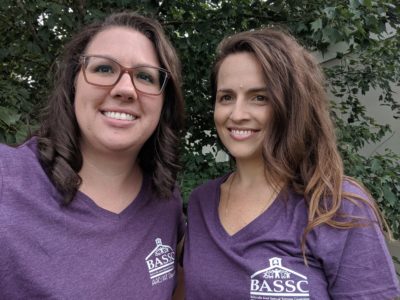
About the Guest Authors
Maggie and Jeanna are speech-language pathologists who work in the Assistive Technology Department for the Belleville Area Special Services Cooperative (BASSC) in southern Illinois. They are AT/AAC facilitators and provide evaluations, direct therapy, consultations, and trainings. You can learn more from them on Instagram (@basscAAC) and their YouTube channel (basscAAC).
Filed under: Featured Posts, PrAACtical Thinking
This post was written by Carole Zangari

2 Comments
I just found this website, I would like to be placed on the email list to start receiving your emails.
Thanks
Sandra, thanks so much for your interest. I just checked and it seems like you are already signed up. Maybe they are going to your spam folder?